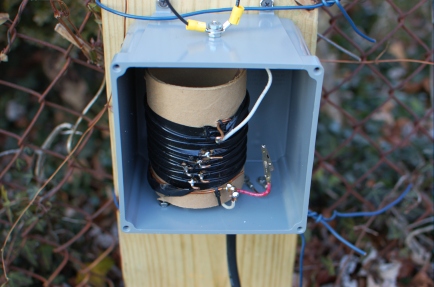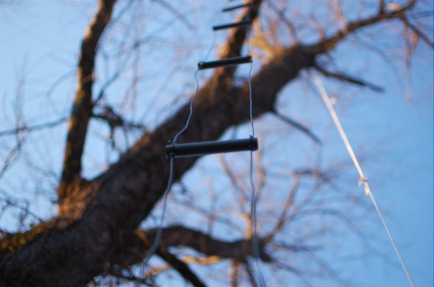Posts Tagged ‘160m’
 160m indoor loft antenna
160m indoor loft antenna
Some years ago G6ALB and I wanted a simple talkback link that we could use when co-operating on experiments. We were 3km apart with Andrew being in the next village. We immediately thought about simple AM rigs for topband (160m).
As I had no 160m antenna, I built the design linked here. This antenna works well with best WSPR spots being over 1000km.
We decided that topband was too noisy for our simple AM rigs for our intended purpose. The noise floor at both our locations is very high on 160m. I have since moved QTH but we are still thinking about this link. We are now 3.3km apart. Probably 6m would be a better choice as less noisy and we both have vertical antennas.
See https://sites.google.com/site/g3xbmqrp3/antennas/160m_loft_ant .
 Poppet 160m AM transceiver
Poppet 160m AM transceiver
This little top band AM transmitter and a companion receiver were first published in the GQRP club SPRAT magazine. This TX version was built by M0DAD. Where the noise floor allows, 160m AM is quite popular for local nets. There is something nice about “rolling your own” builds and getting satisfying results without spending a fortune. For daytime local use 160m AM is a great mode and rigs are simple. I am still surprised that more is not made of AM on 10m at night for local nets here in the UK.
See http://www.delboyonline.co.uk/m0dad/construcion/poppet_top_band_am_transmitter.htm.
 160m/80m DC transceiver
160m/80m DC transceiver
These are bands I rarely use, but some readers may be interested in the Hendricks Kits dual band transceiver. 5.5W sounds enough to work plenty.
These days, the main issue on these bands can be man-made noise from TVs, SMPUs and similar. At my old QTH I had an S7-8 noise floor on 160m and 80m. At the new QTH the noise floor on these bands is low currently, but this could change overnight. Some people use loops and nullers on RX to minimise problems. If you have a quiet noise environment then this transceiver may fit your needs. Don’t forget you will need a reasonably big antenna to get decent results. A half wave 160m dipole antenna is around 240 feet long.
In my youth we had rigs like the Codar AT5 12W AM/CW 160m/80m transmitter and companion T28 RX. I had the RX but not the TX although I did use an AT5 from the QTH of the late G4PJ. The T28 was mainly used as a tunable IF for my 2m converter. I heard my first 2m satellite signals via Oscar 6 and 7 using the T28 as a tunable IF. I remember being very thrilled hearing my first transatlantic stations on the top end of 2m.
 A short vertical for 160 meters
A short vertical for 160 meters
160 meters, Topband, …the names conjure all sorts of visions of grandeur, enigmatic propagation modes, and big antennas in the minds of hams everywhere. Since I have lived on suburban lots for the past five and a half years and in an apartment for two years before that, it has been the better part of a decade since I’ve had my own permanent 160-meter antenna system at my “home” station. (Despite this, I did manage to get 160-meter WAS from NO9Z’s station and if my Rhode Island and Delaware contacts ever upload to LoTW, I’ll request the certificate from ARRL.)
So, the story at hand. Just before the November Sweepstakes contest, I put up a secondary 80-meter antenna—the open-wire fed dipole I used at K8GU/9. Its performance was underwhelming and the vertical seemed to play just fine. But, I got busy and just left it up in the trees. Somewhere in the annals of the Blog, I may or may not have described this antenna, which was designed to also operate on 160 by shorting the feeder and feeding the whole mess against ground. I never used this functionality because I had to lay radials on top of the patio and that was a pain to take them up and put them down.
The North American QSO Party was this weekend and I’ve been participating in the NCCC Sprint Ladder, both of which include 160 meters. Around about last Thursday, after the NS Ladder, I decided it might be fun to have 160 for the NSL and NAQP. So, I ducked out of the office early on Friday afternoon and set about stripping the old tuning network from the K8GU/9 incarnation of the antenna.
We have a lot of AM broadcast stations in the DC area. And, because of that, antenna analyzers are not always too useful on the low bands. So, knowing already that the antenna was near self-resonance after my K8GU/9 efforts, the first thing I did was just hook the antenna up to a TS-930 and give it a 5-10 watts fed against my nearby 80-meter vertical’s radial field. Sure enough, the VSWR was about 3 at 1.999 MHz and off-scale at 1.801 MHz. So, I inserted the loading coil from the old matching box. The coil is just #14 THHN solid wire in approximately the optimum-Q configuration of diameter to length and wound on a cardboard shipping tube. (As is clear from the photograph, it’s not really pretty nor the lowest-loss possible. But, it was great for what I had on-hand.)
The coil has four taps on it. I clipped the fourth tap, shorting the bottom half of the inductor and did the VSWR sweep, finding a dip at 1.950 MHz or so. Each successive tap brought the minimum lower and lower. With no taps clipped, it was tuned to the bottom of the band. I got lucky (erm, did a lot of tweaking at the previous QTH).
The best news of all of this is that there is enough RF actually being radiated (not just as heat, either!) to make some contacts! Further good news is that even though the antenna is between three and five feet from my 80-meter vertical, with the W3NQN filters, I can operate SO2R on both bands simultaneously. Of course, the RX noise level may just be hiding the trash. I haven’t tried the K9AY because I had that portion of the station torn-up during the conversion of all my DC accessories to PowerPoles and the preamp popped a fuse in my RigRunner when I plugged it back in.
The bottom line is that it’s not a full-sized 4-square, but it gets me on 160 from my lot in a way that’s compatible with my operating style.














